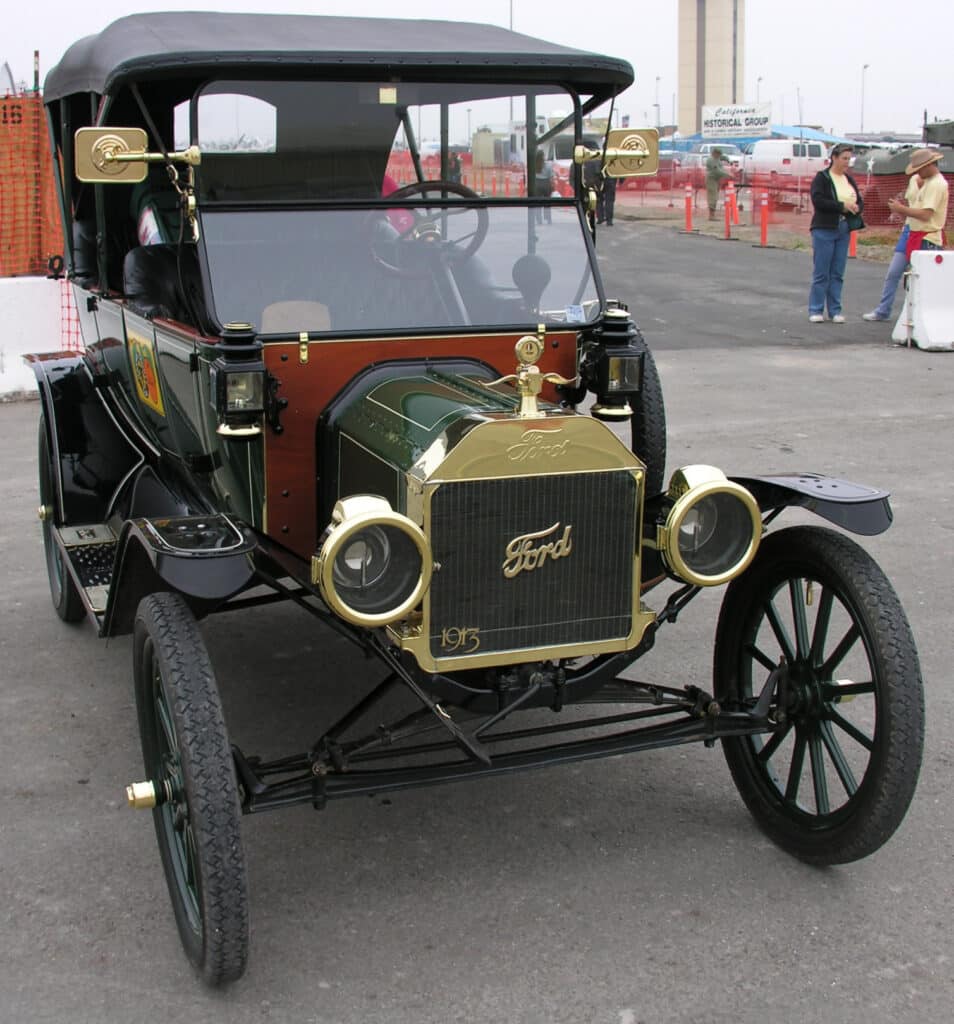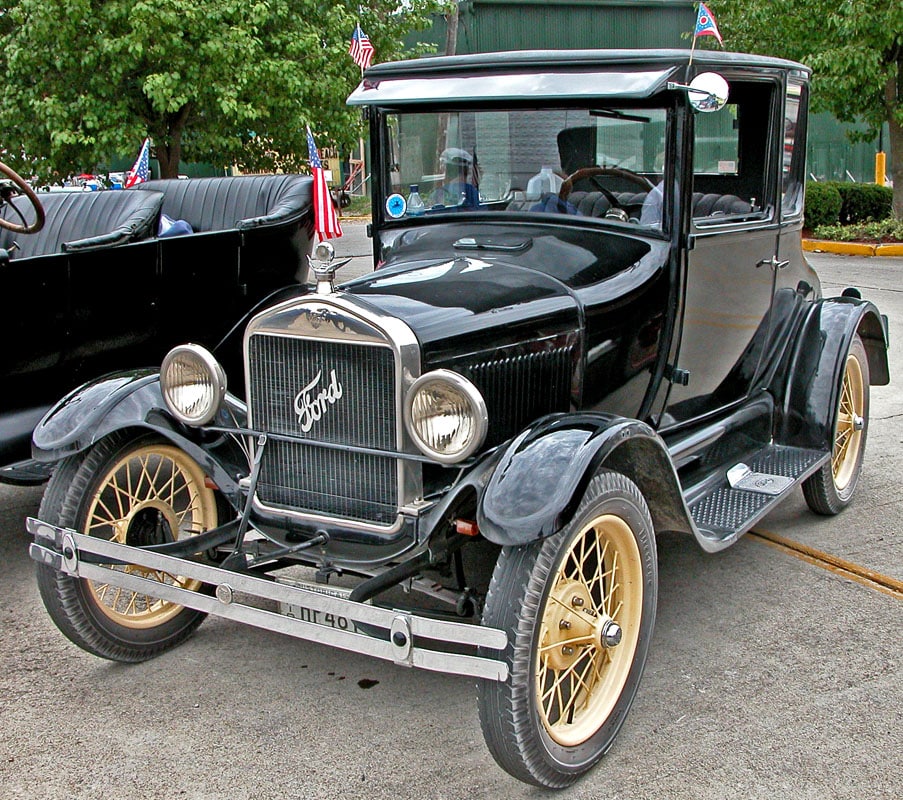Ford Model T
The Ford Motor Company introduced the legendary Ford Model T, also called the “Tin Lizzie” or “Leaping Lena,” in 1908. It was the first mass-produced automobile, with more than 15 million Model T models sold by the time the Ford Motor Company ceased its production on the 26th of May, 1927. The Model T is widely regarded as the most influential vehicle in automotive history. Amazingly, a good number of the original Model Ts are still running today.
The Model T is Invented
The inspiration behind the Model T was Henry Ford. When he founded the Ford Motor Company in 1903, Ford knew what kind of car he wanted to build. The vehicles being produced at that time were few and expensive, so only the wealthy owned them. Also, many of them were unreliable. The sorry state of the roads in those times may have had something to do with that. So, Ford set out to make a car that addressed all these issues. A dependable vehicle that middle-class Americans could afford to own and maintain and a vehicle that could take on a wide variety of domestic and commercial roles. In his book – “My Life and Work,” Ford talked about building a “car for the great multitude.”
Ford started on this quest with models like the Model A (1903-1904), Model C (1904-1905), Model F (1905-1906), Model N (1906-1908), Model R (1907), Model S (1907-1908), and finally, the Model T. With each model, the company took note of all weak points and made improvements to the next model. As a result, it sold more of the Model N, R, and S cars.
With the Model T, Ford was confident the company had finally gotten the formula right – a basic, affordable, and reliable car that fully met the transportation needs of its owners. He was so confident with it that he did not change the Model T’s core attributes over its nineteen-year production run; its body styles evolved, but its engine, chassis, and drivetrain did not change much. Many argue that this unflinching approach to the Model T’s design is what led caused its termination.
Body and Chassis of the Ford Model T
The Model T’s chassis was made from Vanadium Steel, a highly durable steel alloy with high tensile strength and less weight than regular steel. All the Model T models had a 100-inch-wheelbase and were available in several body styles, the most common being a two-seater runabout, a 5-seater touring car, or a 7-seater town car. Also, all Ford Model T models are rear-wheel-drive.
Engine and Transmission of the Ford Model T
The Ford Model T is driven by a 2.9L four-cylinder engine with a one-piece cylinder block and a detachable cylinder head. It is also made from Vanadium steel, so its structure is strong yet lightweight. The engine develops 20 horsepower and can propel the car to a top speed of 42 mph. That was plenty quick back in the day. This engine pairs with a 2-speed planetary-gear-type transmission.
Suspensions of the Ford Model T
The folks at Ford Motor Company gave special attention to the Model T’s suspension because they wanted to make it as capable as possible on the dilapidated farm roads of those times. They equipped it with transversely mounted semi-elliptical springs at all four wheels that delivered commendable ride quality while allowing a great deal of wheel articulation.
The First Examples
The Model T’s initial pricing started at $825 for the runabout models in 1909. The town cars and touring cars were pricier. That price was equivalent to approximately 18 months’ salary for an average American at that time, so not many people were able to buy those models. Only 10,666 units were produced and sold in 1909.
Also worth noting is that the models made between 1909 and 1914 had acetylene gas flame headlights, so their owners had to light each headlight before driving out in the dark. These models were available in gray, green, red, and blue colors, but not black. They had a straight, five-sided hood that featured a flat top.

The 1914-1925 Models
In his “My Life and Work” book, Ford documented that he mentioned during a meeting in 1909 that customers could have any Model T car they wanted, so long as it was black. Apparently, this quote was taken literally by the Ford Motor Company between 1915 and 1925 because most Model T cars made during that period were black. To understand Ford’s words, you have to understand his reasoning concerning what Americans needed in a vehicle at the time. Ford felt that more focus should be given to a car’s functionality and capability than its styling. This philosophy is seen in how the Model T was built. It was a no-frills, unpretentious, and basic car with no suggestion of refinement, but it fully delivered as a solid means of transportation.
There was another reason why the company started painting their Model Ts black. Apparently, black was the only color that could dry quickly enough to keep up with the production of the Model T. Right from when it was introduced, the Model T promptly gained popularity. The demand for its different models increased each year, so Ford started looking for ways to increase its production. In 1913, the company succeeded in setting up a moving assembly line system for the Model T that cut its production time from 12 hours to just 93 minutes; this move reduced production costs significantly while significantly increasing production. By the end of 1913, the company had sold 170,211 units that year, up from 68,773 units the previous year. In 1914, the Model T’s production increased further to 202,667 units. By 1925, the company was selling over 1.9 million Model T units per year.

Rather than keep prices high and make handsome profits, Ford chose to pass the savings on to the people. This made the Model T even more popular. When production started increasing in 1913, Ford reduced the Model T’s price to $525 for the two-seater runabout, down from $590 the previous year. The following year, he reduced the price to $440 and then to $390 the next year (2016). By 1925, the Model T runabout was retailing for just $260.
The Model T Ends
Ford’s unwillingness to improve the Model T formula came back to bite him. By the mid-twenties, many of the company’s competitors were making similarly-priced cars that were more refined and better equipped. As a result, the Model T’s popularity began to wane in 1926, so the company sold way fewer units than it did the previous year. Ford saw the writing on the wall and decided to pull the plug on the project in mid-1927 to allow for the retooling of the assembly line in preparation for the next car project – the 1928 Model A.
The Ford Model T is Not the Easiest Car to Drive
It is hard to imagine how such a cool-looking, time-honored vintage car like the Ford Model T could be so challenging to drive. Ford introduced it way before the automatic transmission was invented, so it has a manual transmission. However, its transmission and drivetrain are anything but straightforward. Its brake pedal is positioned where the accelerator pedal should be, and its reverse pedal is where the brake pedal should be. Only its clutch pedal is where it ought to be; however, it doesn’t function like a standard clutch. “So, where is the accelerator pedal (you may ask)?” The car has a hand throttle instead on the side of its steering wheel.
After starting the car using its crank starter, you float your foot on the clutch pedal, release the handbrake by moving it down from its middle position, then push the clutch pedal down as you feather the throttle; that will put it into low gear. As the car accelerates to approximately ten mph, you then lift your foot off the clutch pedal as you give it more gas; that will put it into high gear.
The Model T changed the world in more ways than one. By 1921, over 57 percent of the vehicles produced worldwide were Model T cars, which is why it is often referred to as the world’s first global car. As its numbers increased, it encouraged the building of roads in cities and towns across the globe. It also inspired the introduction of many other car brands and models. The Ford Model T will forever have an honored place in automotive history.





